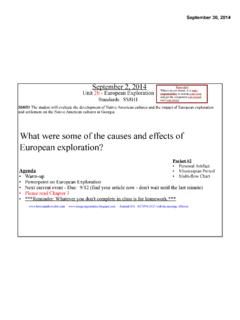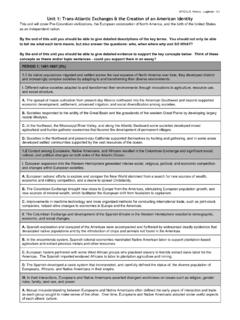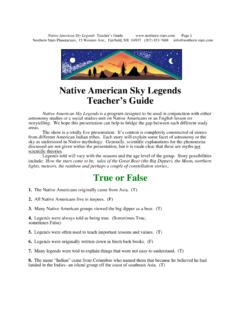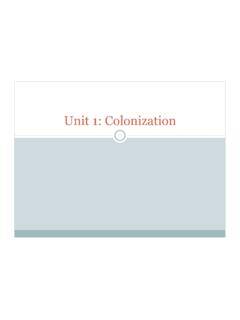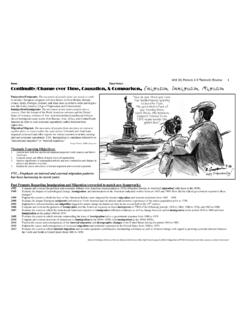Transcription of Unit 2: Native American Cultures - Mr. Washington's Social ...
1 10/6/2013. unit 2: Native American Cultures Today's Schedule: Do now Beringia Native American Cultures Exit slip The Arrival of Men (worksheet). I can explain the Beringia Land Theory. American Heritage: Native Americans 21:52. By: Mr. Washington Native American Cultures (Beringia Land Do Now: Bridge). About 30,000 years ago the world was experiencing an Ice List any questions that Age Water levels dropped revealing a land bridge and many you have pertaining islands that were previously under water Scientists believe that the first Americans migrated from about the Economics Asia to Alaska across Beringia These nomadic people were following mammoths and unit we just finished.
2 Other prey that moved in search of grazing land. Migration to North Americas 2:02. Survival in the Americas Native Americans learned to use the natural resources in their environments for food, clothing, and shelter (SURVIVIAL). At the end of the Ice Age nomadic hunters and gatherers began to settle in one place and learned to farm District Cultures developed Farming encouraged the growth of permanent communities 1. 10/6/2013. Exit-slip Today's Schedule: Quiz (Do now). Native Americans of the Northwest and Great Plains Explain the Regions Totem Pole Activity Exit slip Who Came First (worksheet).
3 Beringia Land culture Areas of North America (map). People of the Plains (reading). I can explain how North American Civilizations developed. Bridge Theory. I can compare and contrast Social institutions between different groups. Cultural Regions NORTHWEST COAST. The Tribes of the Northwest Coast 3:11. made totem poles lived in cedar plank houses salmon main food hunted whales enjoyed potlatches The Great Plains Treeless, grassless Followed buffalo herds Native Americans of the Great Plains relied Lived in teepees upon the buffalo for life!!! People of the Great Plains 2:29.
4 2. 10/6/2013. Students will read a passage about Totem Exit-slip Pole making. After they finish reading, they will trace or cut out 5 pieces to the totem pole. They will then color and Describe the different construct their totem poles. aspects of both the Northwest and Great Plains Indians. Today's Schedule: Do Now: Do now Why did the Finish Great Plains Regions Native Americans of the Southwest and Northeast Regions Exit slip Waste Not, Want Not (worksheet)- in class .. People of the Southwest (reading). People of the Northeast Woodlands (reading) Northwest Indians I can explain the influence of the Spanish in the early Americas.
5 Make totem The Buffalo and the Native Americans 1:52 poles? Secure access to food Horses were brought by the Spanish With horses the Indians had a secure access to food and all the things they needed to live Plains Indians used every part of the buffalo to provide Changed the way Native Americans hunted: everything they needed. Before the horse, men left their villages and traveled out on the plains to hunt for the buffalo on foot Women, children and old people stayed behind in the Could travel farther distances village Before the horse, women and children stayed behind After the hunt, meat was taken back to the village while the men went on long hunts Horses could carry people--women, children.
6 Older men With horses men followed the buffalo across the plains and women--on their strong backs and families moved with the men Horses could carry heavy loads like a travois Teepees could be pulled along so entire tribes could move together 3. 10/6/2013. Trade Increased Horses made it possible for Indians from one part of the Horse Travois Great Plains to travel, meet other Indians, and exchange ideas Wooden frame (two long poles) pulled by horses Before the arrival of horses, dogs were used to pull the travois Enabled Plains Indians to haul heavy loads The Southwest Region People of the Southwest 1:49.
7 Pueblo hot, dry climate farmed by building irrigation ditches grew corn, beans, squash lived in large apartments made of sun dried clay (adobe). wore clothing made of cotton (cotton grows wild in the desert). Heavily influenced by the Spanish The Northeast Woodland Exit-slip many lakes, forest men hunted bear, deer, turkey, birds, Describe the different small game, fished from lakes women farmed (corn, beans, squash). lived in long-houses aspects of both the Iroquois Confederacy developed in New York around the great lakes Northeast Woodlands The Eastern Woodlands People 2:07.
8 And Southwest Indians. 4. 10/6/2013. Today's Schedule: unit Activity review unit Task: Create a mini-poster that represents life in your community culture Activity Your poster must address four elements of culture and contain an illustration and a short explanation for each element. I can explain Social institutions of a culture . (family, religion, education, government, and dress traditions/customs economy) housing religion/beliefs food language/communication art/literature/music/dance/crafts Today's Schedule: Do now Mesoamerican Cultures OH! THE POWER OF CORN. Exit-slip I can explain the importance of agriculture to Mesoamerican Cultures .
9 Mesoamerica: A History of Central America 55:26. Agriculture and the Development Civilization 1:49. Do Now: Mesoamerica hot, humid, much rain Explain different mountains, jungle corn was first farmed in Mexico aspects of a theocracy--religious leaders ruled society culture . Historical Importance of Corn 2:50. 5. 10/6/2013. Farming Started Here OH! THE POWER OF CORN. About 9,000 years ago, people in present day Mexico made a ?discovery that would change the lives of Native Americans for thousands of years. They learned how to plant and use maize, an ?early form of corn. A) Identify Two changes this discovery brought to the lives of Native Americans.
10 B) Choose ONE of the changes identified in part A and explain in detail why it was an important change. A). steady/reliable food supply villages and permanent communities developed need for laws (property issues) and government B). A steady reliable food source was an important change in the lives of the Native Americans. They no longer had to move constantly in search of food. A better diet would have improved their health and well-being. Babies would be born stronger and people would live longer. Today's Schedule: The Olmec Civilization review Mesoamerica The Olmec developed along the Do now Mexican Gulf coast among the lowland Olmec/Maya/Aztec Civilizations jungles, grasslands, and swamps They built large ceremonial and Inca, Aztec, Maya (map) commercial centers between about Be Attractive the Classic Maya Way!


